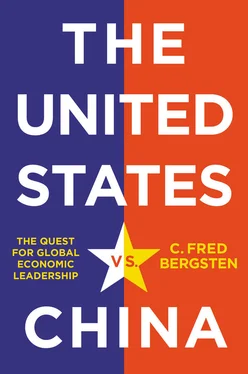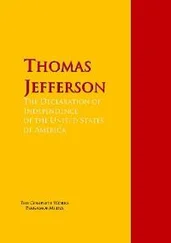But China presents the first real challenge to American economic supremacy since the United States became the world’s premier economy over a century ago. The Soviet Union was a formidable military rival throughout the Cold War, and forced a bipolar security configuration, but was never a serious economic player. Japan became a tough economic competitor but had less than half the population of the United States and depended on America for its national security. The European Union (EU) is as large as the United States economically but only acts together on a limited range of issues. China’s rise creates both a new bipolar foundation for the world economy and an unprecedented rival for the United States.
Like any rising power, China wishes and expects to become a respected global leader – whether or not it exhibits responsible leadership characteristics. Like any country, its international goals are rooted in its domestic imperatives. In this case, China wants the world to remain safe for the continued dominance of the Chinese Communist Party (CCP) in Beijing, above all. It resists external pressures and values that could threaten that supremacy. It increasingly projects its own pressures and values on other countries.
Chapter 4addresses the central systemic question of whether China is satisfied or dissatisfied with the current international economic order. The answer is mixed and nuanced. China has benefited enormously from the open system created and nurtured by the United States and its allies, and recognizes as much. China consciously opted to engage with that system, including membership in all of the major international economic institutions, as an integral part of its development strategy. The payoff has been spectacular in terms of China’s economic growth and globalization. China is quite satisfied with these results.
However, China is now emphasizing domestic rather than international drivers of growth. It is seeking to reduce its dependence on outside forces, for security as well as economic reasons. The external share of its economy, though still substantial, has dropped dramatically over the past 15 years. It has embraced a degree of government intervention and state guidance that were not anticipated a decade ago. Hence, China’s reliance on an open world economy, and its interest in maintaining that regime, may be declining – although they remain sizable.
China is increasingly distinguishing between the United States and the rest of the world. It is clearly decoupling to some extent from America, in response to the trade war and broader deterioration of relations. It is continuing to expand its economic ties with most other countries. An exception as of this writing is Australia, with which China is engaged in a mini-confrontation.
China dislikes some of the key rules and norms that underpin the current system: market forces rather than state control of the economy, democracy and rule of law rather than authoritarian politics. These features differ profoundly from China’s own preferences. It also believes that it should be playing a much larger role in that system.
China is thus partially dissatisfied, as well as partially satisfied, with the system. To date, it has mainly sought to increase its role within the existing order and institutions, rather than to overthrow or even radically reform them. It has behaved as a revisionist, rather than a revolutionary superpower.
China has also, however, flouted key rules and norms of the traditional system even while loudly proclaiming support for it. Its massive currency manipulation in the first decade or so of the new century totaled several trillion dollars and destroyed millions of jobs in the United States and other countries (Bergsten and Gagnon 2017). Its subsidies, theft of intellectual property and forced transfers of technology cost other countries tens or even hundreds of billions of dollars annually; Schadlow (2020) reports that “experts estimate that since 2013 the United States has suffered over $1.2 trillion in economic damage as a result of China’s egregious abuses.” China has helped to defend the open international economic order on several crucial occasions but has also undermined it severely, as its growing importance heightened the impact of its pervasive cheating and the growing backlash against it from other countries.
China has also led the creation of new institutions that magnify its clout, some of which (like the Asian Infrastructure Investment Bank [AIIB]) fit well into the extant order, and some of which (like the BRI) may not. It is pushing to establish new international rules in domains where none now exist – such as the Internet, and cybersecurity more broadly – that would favor its state-centric preferences rather than the traditional market-oriented approach of the West. It is seeking opportunistically to enhance its role, and to alter the rules and norms in directions more to its liking, with an eye to protecting the CCP and eventually catching up (at least) with the United States. It could make a “dash for dominance,” as will be discussed in chapters 4and 8.
China appears to believe that it is getting the best of both worlds from the present international economic order. It gains hugely from the order’s openness while cheating on the rules – without eliciting much pushback before President Trump’s (ineffectual) tariffs – when it sees advantage in doing so. The basic systemic question is whether China believes it can continue to get away with this strategy without undermining the system itself, which it risks through generating backlash against its practices from the United States and other countries that both defend the system and suffer from China’s exploitation of it. To modify its behavior sufficiently to alleviate this threat to systemic stability (and thus to its own interests), China will have to be persuaded – preferably through its internal debates and by Asian neighbors, rather than by the United States or close US allies – to accept key principles of the regime.
The United States as Incumbent Power
The United States is not a declining power in any generalized sense, as will be seen in chapter 5. It has in fact grown faster than most of the other high-income countries over the three decades since the end of the Cold War, and thus expanded its economic lead over them. Its share of the world economy has obviously declined sharply from the early postwar period, when most countries were still recovering from the Second World War, but remains about where it was in 1990. Any US decline is only against China and a very few other emerging markets, and is a reflection of their rise against everybody rather than its own demise.
For all its many problems, and the need to greatly improve its performance across a wide range of issues – from productivity growth to fiscal sustainability to better income distribution to political dysfunction – the United States seems likely to continue growing at a respectable pace for the foreseeable future when measured against both its own historical record and the prospects for other industrialized nations. It has the capability to maintain a major share of global economic leadership as far ahead as the eye can see. China’s relative rise has been mainly at the expense of countries other than the United States.
Moreover, US leadership has traditionally been strongly supported by a powerful set of reliable allies – the “hegemonic coalition.” The group has included all of Western Europe (and, since the end of the Cold War, most of Eastern Europe), Japan, South Korea, Canada, Australia, New Zealand, and indeed most of the OECD (Organisation for Economic Co-operation and Development) club of high-income nations. The GDPs of these countries, taken together, roughly equal that of the United States and thus double the global weight of the coalition. We will see in Part II of this book that they extend the “US lead” over China by several decades on many of the relevant metrics of international economic capability.
Читать дальше












